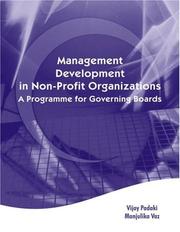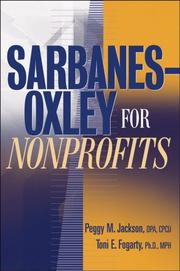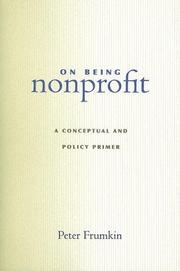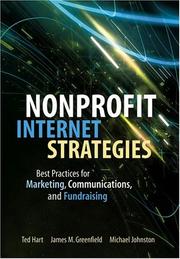| Listing 1 - 9 of 9 |
Sort by
|

ISBN: 0821363123 9786610223886 128022388X 0821363131 Year: 2005 Publisher: Washington, D.C. : The World Bank,
Abstract | Keywords | Export | Availability | Bookmark
 Loading...
Loading...Choose an application
- Reference Manager
- EndNote
- RefWorks (Direct export to RefWorks)
Local organizations have become key mechanisms in effective, fair, and sustainable resource management and development in India. This book adds empirical evidence to the debate on whether or not these functions are performed as expected. Based on research in three sectors in three states in India, the authors' findings indicate that the design of and support for local organizations are often little more than rudimentary, resulting in less than adequate performance and raising serious sustainability concerns. Two debates dominate discourse on the roles of organizations. The first is a practical
Third World: economic development problems --- India --- Nonprofit organizations --- Charities --- Corporations, Nonprofit --- Non-profit organizations --- Non-profit sector --- Non-profits --- Nonprofit sector --- Nonprofits --- Not-for-profit organizations --- NPOs --- Organizations, Nonprofit --- Tax-exempt organizations --- Associations, institutions, etc.

ISBN: 8132111737 128207542X 9786612075421 8132102150 9788132102151 9788132111733 9788178295206 8178295202 0761933778 8178295202 9780761933779 9352800613 9789352800612 9781282075429 Year: 2005 Publisher: New Delhi ; London : SAGE,
Abstract | Keywords | Export | Availability | Bookmark
 Loading...
Loading...Choose an application
- Reference Manager
- EndNote
- RefWorks (Direct export to RefWorks)
Designed as a self-help manual for board members of non-profit organizations, this text covers a number of crucial areas of management development including setting up an organization organizational growth and development, and dealing with emerging demands and challenges.
Boards of directors --- Nonprofit organizations --- Corporations, Nonprofit --- Non-profit organizations --- Non-profit sector --- Non-profits --- Nonprofit sector --- Nonprofits --- Not-for-profit organizations --- NPOs --- Organizations, Nonprofit --- Tax-exempt organizations --- Associations, institutions, etc. --- Boards of supervision (Corporation law) --- Management.

ISBN: 0415314186 0415314194 9780415314190 9780415314183 Year: 2005 Publisher: London: Routledge,
Abstract | Keywords | Export | Availability | Bookmark
 Loading...
Loading...Choose an application
- Reference Manager
- EndNote
- RefWorks (Direct export to RefWorks)
Nonprofit organizations --- Microéconomie --- Gouvernance --- Comptabilité --- Fondations --- Associations --- Intérêt (économie politique) --- #SBIB:35H300 --- #SBIB:051.IOS --- AA / International- internationaal --- 347.452 --- Organisatieleer: algemene werken --- Burgerlijke vennootschappen. Verenigingen. --- Nonprofit organizations. --- Corporations, Nonprofit --- Non-profit organizations --- Non-profit sector --- Non-profits --- Nonprofit sector --- Nonprofits --- Not-for-profit organizations --- NPOs --- Organizations, Nonprofit --- Tax-exempt organizations --- Burgerlijke vennootschappen. Verenigingen --- Microéconomie. --- Gouvernance. --- Comptabilité. --- Fondations. --- Associations. --- Associations, institutions, etc. --- Management: non-profit.
Book
ISBN: 8884532884 8884532876 9788884532879 Year: 2005 Volume: 12 Publisher: Firenze University Press
Abstract | Keywords | Export | Availability | Bookmark
 Loading...
Loading...Choose an application
- Reference Manager
- EndNote
- RefWorks (Direct export to RefWorks)
Attraverso il bilancio sociale si misurano e si valutano i risultati conseguiti da un ente non profit sotto il profilo economico-sociale. Alla luce di questa osservazione è stato avviato il progetto "BILANCIO SOCIALE DEGLI ENTI NON PROFIT", che vede coinvolti Regione Toscana, Province di Firenze e Pistoia, Cesvot, associazione Le Reti di Kilim e Dipartimento di Scienze Aziendali dell'Università degli Studi di Firenze. Il percorso di ricerca, finalizzato all'individuazione di un modello di riferimento per il processo di rendicontazione sociale delle organizzazioni del terzo settore, dopo una signifi - cativa fase di ricerca teorica che ha dato luogo al quaderno PISR n. 2, Alcune considerazioni in tema di bilancio sociale del maggio 2002, ha reso evidente l'opportunità di procedere ad una concretizzazione di quanto elaborato. In altre parole, si è trattato di applicare le conclusioni teoriche precedenti ad alcuni enti "pilota" e di raccontare questa esperienza. Nello specifico, vengono riportati alcuni bilanci sociali alla cui realizzazione hanno partecipato gli autori del presente quaderno. Per ciascuno di questi è stata elaborata una griglia riassuntiva e di commento, con la finalità di facilitarne una lettura comparata. Social accounting is a way of measuring and assessing the economic and social results achieved by a non-profit body. It is in the light of this observation that the project "SOCIAL ACCOUNTING OF THE NON-PROFIT BODIES" has been launched, involving the Tuscan Regional Authority, the Provincial Authorities of Florence and Pistoia, Cesvot, Le Reti di Kilim association and the Department of Business Science of the University of Florence. An important phase of theoretical research resulted in the publication PISR no. 2, "Observations on the issue of social accounting" in May 2002. Following this, the research approach finalised at the identification of a model of reference for the social accounting process of third sector organisations highlighted the need to concretise what had been elaborated. In other words, to apply the previous theoretical conclusions to certain "pilot" bodies and to report on the experience. More specifically, this work reports several processes of social accounting in which the authors have taken part. For each of these a grid of summary and comments has been prepared, with the purpose of facilitating a comparative reading.
Nonprofit organizations --- Cooperation --- Social service --- Management --- Business & Economics --- Industrial Management --- Benevolent institutions --- Philanthropy --- Relief stations (for the poor) --- Social service agencies --- Social welfare --- Social work --- Collaborative economy --- Cooperative distribution --- Cooperative movement --- Distribution, Cooperative --- Peer-to-peer economy --- Sharing economy --- Corporations, Nonprofit --- Non-profit organizations --- Non-profit sector --- Non-profits --- Nonprofit sector --- Nonprofits --- Not-for-profit organizations --- NPOs --- Organizations, Nonprofit --- Tax-exempt organizations --- Human services --- Economics --- Profit-sharing --- Associations, institutions, etc. --- Toscana --- Economia --- Enti no profit --- Terzo settore --- Cooperazione

ISBN: 0471697885 9786610255238 1280255234 0471731994 9780471697886 9780471731993 9781280255236 6610255237 Year: 2005 Publisher: Hoboken, N.J. : John Wiley & Sons,
Abstract | Keywords | Export | Availability | Bookmark
 Loading...
Loading...Choose an application
- Reference Manager
- EndNote
- RefWorks (Direct export to RefWorks)
A complete guide to leveraging the power of Sarbanes-Oxley--specifically for nonprofitsThe first book to discuss the implications of Sarbanes-Oxley legislation as it relates to nonprofit organizations, Sarbanes-Oxley for Nonprofits is an essential guide for all nonprofit executives and boards who want to know how the new legislation can enhance their organization's mission.By establishing a ""platinum standard"" of operations and governance within nonprofit organizations, executives and board members will be better equipped to attract high-quality staff and board members, as we
Nonprofit organizations - Accounting - Law and legislation. --- Nonprofit organizations - Auditing - Law and legislation. --- Nonprofit organizations - United States - Finance - Management. --- Nonprofit organizations - United States - Management. --- Nonprofit organizations. --- United States. --- Financial Management & Planning --- Finance --- Business & Economics --- Nonprofit organizations --- Management. --- Accounting --- Law and legislation. --- Auditing --- Corporations, Nonprofit --- Non-profit organizations --- Non-profit sector --- Non-profits --- Nonprofit sector --- Nonprofits --- Not-for-profit organizations --- NPOs --- Organizations, Nonprofit --- Tax-exempt organizations --- Associations, institutions, etc. --- Finance&delete& --- Management --- Accounting&delete& --- Law and legislation --- Auditing&delete& --- E-books

ISBN: 0674018354 0674007689 0674037405 9780674037403 9780674007680 0674263421 Year: 2005 Publisher: Cambridge, Mass. Harvard University Press
Abstract | Keywords | Export | Availability | Bookmark
 Loading...
Loading...Choose an application
- Reference Manager
- EndNote
- RefWorks (Direct export to RefWorks)
This concise and illuminating book provides a road map to the evolving conceptual and policy terrain of the nonprofit sector. Drawing on prominent economic, political, and sociological explanations of nonprofit activity, Peter Frumkin focuses on four important functions that have come to define nonprofit organizations. The author clarifies the debate over the underlying rationale for the nonprofit and voluntary sector's privileged position in America by examining how nonprofits deliver needed services, promote civic engagement, express values and faith, and channel entrepreneurial impulses. He also exposes the difficult policy questions that have emerged as the boundaries between the nonprofit, business, and government sectors have blurred. Focusing on nonprofits' growing dependence on public funding, tendency toward political polarization, often idiosyncratic missions, and increasing commercialism, Peter Frumkin argues that the long-term challenges facing nonprofit organizations will only be solved when they achieve greater balance among their four central functions. By probing foundational thinking as well as emergent ideas, the book is an essential guide for nonprofit novitiates and experts alike who want to understand the issues propelling public debate about the future of their sector. By virtue of its breadth and insight, Frumkin's book will be an invaluable resource for anyone interested in understanding the complex interplay of public purposes and private values that animate nonprofit organizations.
Nonprofit organizations. --- Corporations. --- Business corporations --- C corporations --- Corporations, Business --- Corporations, Public --- Limited companies --- Publicly held corporations --- Publicly traded corporations --- Public limited companies --- Stock corporations --- Subchapter C corporations --- Corporations, Nonprofit --- Non-profit organizations --- Non-profit sector --- Non-profits --- Nonprofit sector --- Nonprofits --- Not-for-profit organizations --- NPOs --- Organizations, Nonprofit --- Tax-exempt organizations --- Sociology of social care --- Firms and enterprises --- Community organization --- Business enterprises --- Corporate power --- Disincorporation --- Stocks --- Trusts, Industrial --- Associations, institutions, etc.

ISBN: 9780470015056 0470015055 Year: 2005 Publisher: Chichester John Wiley & Sons, Ltd
Abstract | Keywords | Export | Availability | Bookmark
 Loading...
Loading...Choose an application
- Reference Manager
- EndNote
- RefWorks (Direct export to RefWorks)
Community organization --- Nonprofit organizations. --- Charitable uses, trusts, and foundations. --- #SBIB:35H300 --- #SBIB:316.334.2A510 --- Organisatieleer: algemene werken --- Organisatiesociologie: morfologie van de onderneming, incl. KMO’s --- Charitable uses, trusts, and foundations --- Nonprofit organizations --- Corporations, Nonprofit --- Non-profit organizations --- Non-profit sector --- Non-profits --- Nonprofit sector --- Nonprofits --- Not-for-profit organizations --- NPOs --- Organizations, Nonprofit --- Tax-exempt organizations --- Associations, institutions, etc. --- Charitable remainder trusts --- Donations --- Endowments --- Charities --- Charity laws and legislation --- Juristic persons --- Trusts and trustees --- Uses (Law) --- Charitable bequests --- Law and legislation --- Europe --- Évaluation --- États-Unis --- Fondation --- Nonprofit --- Remuneration capital

ISBN: 0471691887 9786610254897 1280254890 0471716197 9780471716198 9780471691884 9781280254895 6610254893 Year: 2005 Publisher: Hoboken, N.J. : Wiley,
Abstract | Keywords | Export | Availability | Bookmark
 Loading...
Loading...Choose an application
- Reference Manager
- EndNote
- RefWorks (Direct export to RefWorks)
Nonprofit Internet Strategies offers every charitable organization the opportunity to analyze their options and select the appropriate strategy to integrate traditional marketing, communications, and fundraising practices with their online efforts. It is an excellent how-to guide--a practical manual for nonprofit staff written in non-technical language--prepared by experts in the field based on real-life experiences and case studies.
Internet marketing - Computer network resources. --- Nonprofit organizations - Computer network resourc. --- Management --- Business & Economics --- Industrial Management --- Internet marketing --- Nonprofit organizations --- Internet. --- Telecommunication. --- Fund raising --- Computer network resources. --- Fundraising --- Money raising --- Prospecting (Fund raising) --- Fund raisers (Persons) --- Social service --- Electric communication --- Mass communication --- Telecom --- Telecommunication industry --- Telecommunications --- Communication --- Information theory --- Telecommuting --- DARPA Internet --- Internet (Computer network) --- Wide area networks (Computer networks) --- World Wide Web --- Corporations, Nonprofit --- Non-profit organizations --- Non-profit sector --- Non-profits --- Nonprofit sector --- Nonprofits --- Not-for-profit organizations --- NPOs --- Organizations, Nonprofit --- Tax-exempt organizations --- Associations, institutions, etc. --- Online marketing --- Web marketing --- World Wide Web marketing --- Electronic commerce --- Marketing --- Finance --- Internet --- Telecommunication --- Computer network resources --- E-books

ISBN: 1280255153 9786610255153 0471727334 9780471727330 Year: 2005 Publisher: Hoboken, N.J. : John Wiley & Sons,
Abstract | Keywords | Export | Availability | Bookmark
 Loading...
Loading...Choose an application
- Reference Manager
- EndNote
- RefWorks (Direct export to RefWorks)
""JoAnn Senger has gone out of the box to address fundamental compensation issues too-often ignored in the public and not-for-profit sectors. She peels away the 'second-class citizen' label and provides effective compensation structures that reward top performers.""--Jonathan Fraser Light Senior Partner, Nordman, Cormany, Hair & ComptonA step-by-step plan to design and manage a compensation system for not-for-profit organizationsWritten by recognized not-for-profit human resource specialist JoAnn Senger, Designing a Not-For-Profit Compensation System provides a step-by-step
Nonprofit organizations --- Public institutions --- Employee fringe benefits --- Executives --- Compensation management --- Compensation administration --- Wage and salary administration --- Personnel management --- Wages --- Business executives --- Company officers --- Corporate officers --- Corporation executives --- Managers --- Management --- Benefits, Employee --- Benefits, Fringe --- Employee benefits --- Fringe benefits --- Non-wage payments --- Perks (Employee fringe benefits) --- Perquisites (Employee fringe benefits) --- Labor costs --- Government institutions --- Institutions, Public --- Institutions, State --- State institutions --- Associations, institutions, etc. --- Corporations, Nonprofit --- Non-profit organizations --- Non-profit sector --- Non-profits --- Nonprofit sector --- Nonprofits --- Not-for-profit organizations --- NPOs --- Organizations, Nonprofit --- Tax-exempt organizations --- Employees --- Salaries, etc. --- Employees&delete& --- Salaries, etc --- E-books
| Listing 1 - 9 of 9 |
Sort by
|

 Search
Search Feedback
Feedback About UniCat
About UniCat  Help
Help News
News